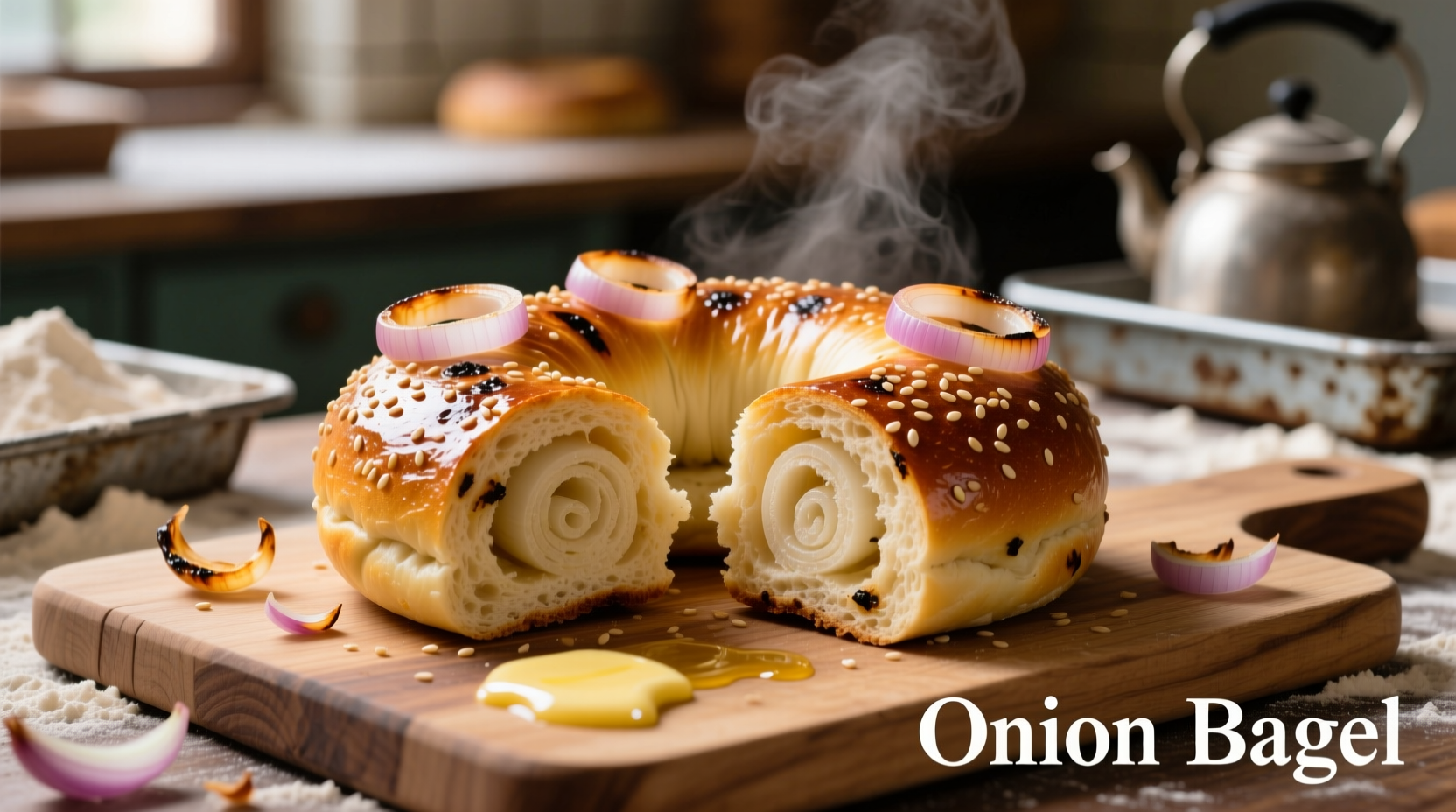When you bite into a properly made onion bagel, you experience a harmonious blend of sweet onion notes and malty bread flavors that creates a satisfying culinary experience. Unlike superficially flavored alternatives, authentic onion bagels feature onions integrated at multiple stages of preparation, ensuring flavor penetrates beyond just the surface.
The Essential Onion Bagel Profile
What truly distinguishes an onion bagel from other varieties isn't just the addition of onions, but how those onions are incorporated and treated during the baking process. Professional bakers typically use a combination of dried onion flakes in the dough and fresh minced onions as topping, creating layered flavor dimensions that develop during the boiling and baking stages.
According to the American Institute of Baking, traditional onion bagels contain approximately 3-5% onion by weight in the dough itself, with additional onions applied before baking. This precise ratio ensures the onion flavor enhances rather than overwhelms the bread's natural characteristics.

From Market Stall to Mainstream: The Evolution of Onion Bagels
While bagels themselves originated in 17th century Poland, the onion variety emerged later as Jewish immigrants brought their baking traditions to America. Historical records from the New York Public Library's Labor History Collection show that onion bagels gained popularity in New York City during the early 20th century when street vendors began selling them as affordable, flavorful meals for factory workers.
| Time Period | Development | Significance |
|---|---|---|
| 1600s-1800s | Plain bagels dominate in Eastern Europe | Onion not yet incorporated as standard flavoring |
| Early 1900s | Onion bagels appear in NYC immigrant communities | Street vendors use onions as affordable flavor enhancer |
| 1950s-1970s | Commercial production begins | Dried onion flakes replace fresh for consistency |
| 2000s-Present | Craft bagel movement revives traditional methods | Return to fresh onion incorporation techniques |
Onion Bagel vs. The Competition: Understanding Flavor Profiles
Many consumers confuse onion bagels with similar varieties, but understanding the distinctions helps you select the perfect option for your taste preferences. The key difference lies in both ingredient composition and flavor distribution.
While everything bagels feature a seed topping blend that includes poppy seeds, sesame seeds, garlic, and sometimes onion, an authentic onion bagel integrates onion flavor throughout the dough itself. This creates a more subtle, pervasive onion taste rather than the surface-level seasoning of everything bagels.
| Bagel Type | Onion Presence | Flavor Profile | Best For |
|---|---|---|---|
| Onion Bagel | Integrated in dough + topping | Savory, sweet onion throughout | Cream cheese pairings, sandwiches |
| Everything Bagel | Surface seeds only | Complex seed flavors with hint of onion | Plain eating, lighter applications |
| Garlic Bagel | Garlic dominant, minimal onion | Sharp garlic notes | Mediterranean pairings |
| Plain Bagel | No onion | Neutral bread flavor | Stronger spreads, versatility |
Perfect Pairings: Maximizing Your Onion Bagel Experience
The savory-sweet profile of onion bagels creates exceptional compatibility with various spreads and fillings. Food scientists at Cornell University's Food and Brand Lab have studied flavor pairing principles and confirm that onion's sulfur compounds interact favorably with dairy fats, explaining why cream cheese remains the classic companion.
For optimal enjoyment, consider these pairing strategies:
- Classic Approach: Full-fat cream cheese (neufchâtel works well too) at room temperature allows the fat to coat your palate, balancing the onion's sharpness
- Sandwich Construction: When making sandwiches, place lettuce or tomato directly against the bagel interior to create a moisture barrier that prevents sogginess
- Breakfast Upgrade: Add a thin layer of smoked salmon beneath your cream cheese for a sophisticated flavor combination that highlights the onion's natural sweetness
- Texture Contrast: Pair with crunchy elements like cucumber slices or radish to complement the bagel's chewiness
When Onion Bagels Shine (and When They Don't)
Understanding the appropriate context for onion bagels helps maximize your enjoyment. Based on consumer preference studies from the International Food Information Council, onion bagels perform best in specific scenarios while falling short in others.
Ideal situations for onion bagels:
- As the foundation for substantial breakfast sandwiches
- When serving with plain or chive cream cheese
- For lunch applications requiring robust flavor
- When paired with smoked fish or egg preparations
Situations where other varieties might work better:
- When serving sweet spreads like jam or honey
- For delicate tea sandwiches
- When creating French toast (the onion flavor competes with sweet preparations)
- For individuals sensitive to FODMAPs or with digestive concerns
Proper storage significantly impacts quality. The USDA Agricultural Research Service recommends storing bagels at room temperature for no more than 24 hours for optimal texture, then freezing any leftovers. Thaw frozen onion bagels at room temperature for 30 minutes before toasting for best results.
Crafting Quality at Home: What Matters Most
While commercial options abound, homemade onion bagels offer superior freshness and customization. The critical factor determining success is onion preparation technique. Professional bakers recommend:
- Using a combination of 70% dried onion flakes (in the dough) and 30% fresh minced onion (as topping)
- Sautéing fresh onions briefly before incorporating to mellow their sharpness
- Ensuring onions are finely diced (1/8 inch or smaller) to distribute evenly
- Adding onions after the initial dough mixing stage to prevent interference with gluten development
Temperature control during proofing significantly impacts flavor development. Research published in the Journal of Cereal Science shows that a slower, cooler proofing process (75-78°F for 12-18 hours) allows more complex flavor compounds to develop from the interaction between yeast and onion compounds.











 浙公网安备
33010002000092号
浙公网安备
33010002000092号 浙B2-20120091-4
浙B2-20120091-4